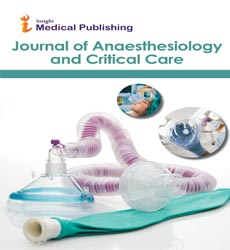The Classification of Analgesics and Its Uses
Claire Goedken*
Department of Anesthesiology, Emory University School of Medicine, Atlanta, GA, USA
- *Corresponding Author:
- Claire Goedken
Department of Anesthesiology, Emory University School of Medicine, Atlanta, GA, USA
E-mail: Claire.goedken@gmail.co
Received Date: November 25, 2021; Accepted Date: December 09, 2021; Published Date:December 16, 2021
Citation: Goedken C (2021) The Classification of Analgesics and Its Uses. J Anaesthesiol Crit Car. Vol.4 No.2:10
Commentary
Any member of the category of medications used to achieve analgesia, or pain relief, is referred to as an analgesic or painkiller. They differ from anesthetics, which alter feeling temporarily and in some cases completely. The nature of pain also influences the choice of analgesic: Traditional analgesics are less effective for neuropathic pain, and medications that aren't generally considered analgesics, such as tricyclic antidepressants and anticonvulsants, can help. Paracetamol, often known as acetaminophen or APAP, is a pain reliever and fever reducer. It's most commonly used to treat mild to moderate pain. Paracetamol is now used in conjunction with opioid pain medications for more severe pain, such as cancer discomfort and following surgery. It's usually taken orally or rectally, although it's also available intravenously. The effects continue for two to four hours. A moderate analgesic, paracetamol is used to relieve pain. At recommended doses, paracetamol is generally safe. These medications are produced from nonsteroidal anti-inflammatory medicines (NSAIDs). It was discovered that the cyclooxygenase enzyme inhibited by NSAIDs has at least two distinct versions: COX1 and COX2. Most of the negative effects of NSAIDs are thought to be mediated by blocking the COX1 (constitutive) enzyme, while the analgesic effects are mediated by the COX2 (inducible) enzyme, according to research. As a result, COX2 inhibitors were created to target specifically the COX2 enzyme (traditional NSAIDs block both versions in general). When compared to NSAIDs, these medications (such as rofecoxib, celecoxib, and etoricoxib) are equally effective analgesics but induce less gastrointestinal haemorrhage. Following the extensive use of COX-2 inhibitors, it was shown that the majority of these medications increase the risk of cardiovascular events by 40% on average. This resulted in the discontinuation of rofecoxib and valdecoxib, as well as the issuing of warnings for other drugs. Morphine, the archetypal opioid, and other opioids (e.g., codeine, oxycodone, hydrocodone, di hydromorphine, pethidine) all ply a analogous influence on the cerebral opioid receptor system. Buprenorphine is a partial agonist of the μ-opioid receptor, and tramadol is a serotonin norepinephrine reuptake asset (SNRI) with weak μ-opioid receptor agonist parcels. Dosing of all opioids may be limited by opioid toxin (confusion, respiratory depression, myoclonic pulls and point pupils), seizures (tramadol), but opioid-tolerant individualities generally have advanced cure ceilings than cases without tolerance. Opioids, while veritably effective anesthetics, may have some unwelcome side- goods. Cases starting morphine may witness nausea and vomiting (generally relieved by a short course of antiemetics similar as phenergan). Pruritus (itching) may bear switching to a different opioid. Constipation occurs in nearly all cases on opioids, and laxatives (lactulose, macrogolcontaining orco-danthramer) are generallyco-prescribed. Anesthetics are constantly used in combination, similar as the paracetamol and codeine medications plant in numerous nonprescription pain relievers. They can also be plant in combination with vasoconstrictor medicines similar as pseudoephedrine for sinus- related medications, or with antihistamine medicines for mis like victims. Several combination analgesic products have been shown to have many efficacy benefits when compared to analogous boluses of their individual factors. Also, these combination anesthetics can frequently affect in significant adverse events, including accidental overdoses, most frequently due to confusion that arises from the multiple (and frequently non-acting) factors of these combinations. Certain Medicines that have been introduced for uses other than anesthetics are also used in pain operation. Both first- generation (similar as amitriptyline) and newer antidepressants (similar as duloxetine) are used alongside NSAIDs and opioids for pain involving whimwhams damage and analogous problems. Other agents directly potentiate the goods of anesthetics, similar as using hydroxyzine, promethazine, carisoprodol, or tripelennamine to increase the pain- killing capability of a given cure of opioid analgesic.
Open Access Journals
- Aquaculture & Veterinary Science
- Chemistry & Chemical Sciences
- Clinical Sciences
- Engineering
- General Science
- Genetics & Molecular Biology
- Health Care & Nursing
- Immunology & Microbiology
- Materials Science
- Mathematics & Physics
- Medical Sciences
- Neurology & Psychiatry
- Oncology & Cancer Science
- Pharmaceutical Sciences
